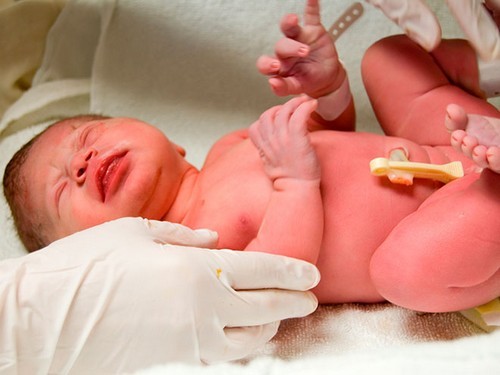In a healthy child, the surface of the tongue is pink, smooth, velvety with evenly located papillae. From time to time, particles of milk or milk mixture may attach to it, so you do not need to worry if you suddenly see a white tongue in a newborn.
After some time, the language will acquire an even natural color.
If this does not happen, and the white coating remains on the tongue of the baby regardless of the meal, you need to pay attention to his health. Most likely, this is a symptom of some kind of pathology, which you need to tell your doctor.
What does the white tongue say in a newborn?
Most doctors believe that any pathological changes that occur in the body will certainly affect the appearance of the tongue.
A white tongue in an infant can talk about the development of the following diseases:
- plaque, covering an even layer of the entire area of the tongue, usually indicates dysbiosis;
- plaque resembling a curd mass with individual grains is a symptom of thrush and stomatitis;
- plaque of a dense structure can appear with food poisoning in a child, disorders of the intestines, problems with stools, less often with infections such as measles, scarlet fever, chickenpox;
- spots on the tongue may indicate problems with the normal functioning of the gallbladder and liver.
Causes
The main causes of white plaque in the tongue of a newborn are the following factors:
- The specifics of nutrition. Since a small child receives food exclusively in the form of mother’s milk or milk formula, which are colored white, it is not surprising that immediately after feeding, the tongue of the crumbs is painted in the corresponding color. Such plaque does not require medical intervention and is easily removed. If the white tongue in the newborn is observed regularly and is not removed with clean water, you should consult a doctor.
- Gastrointestinal tract diseases. If the plaque on the tongue has a dense structure, most likely the child has problems with the stomach or intestines. In this case, it is important to monitor the behavior of the baby. If the child is anxious, he has problems with stools, colic, bloating and flatulence, you need to consult a doctor. Perhaps this is how dysbiosis or constipation manifests itself.
- A dense plaque in the language of the granular structure indicates the development of the inflammatory process: it may be thrush or stomatitis. To verify this, you can try to clear the tongue of plaque in a small area with a soft cloth. If an inflamed mucosa and sores that cause discomfort to a child are detected under a remote plaque, then he has stomatitis.

Dangerous causes of white plaque in infants are:
- anemia;
- neurosis, functional disorders of the nervous system;
- avitaminosis;
- immunodeficiency conditions;
- diabetes.
To accurately determine the cause of the pathology, the doctor will conduct the necessary diagnostics. It is not recommended to self-medicate. If white plaque is found in the tongue, you need to contact the dentist and pediatrician.
Treatment methods
White plaque that appears in the tongue of a newborn does not always require special treatment. If the cause of its appearance is milk or a mixture, it is easy to remove it with water.

A denser coating requires treatment, in which the cause of its formation is necessarily taken into account. Such cases require immediate contact with a pediatrician who will make the correct diagnosis and prescribe appropriate therapy.
In diseases of the gastrointestinal tract, the doctor prescribes treatment for the root cause of the pathology, in this case, white spots in the form of plaque disappear from the child’s tongue on their own in a short time, without additional medical manipulations. It is important to normalize the nutrition of the newborn, if necessary, replace the milk mixture with a hypoallergenic one, and avoid early feeding.
If the white tongue is provoked by pathologies of the nervous system of the newborn, then upon receipt of appropriate therapy, automatic elimination of troubles also occurs. If you suspect a disturbance in the functioning of the nervous system, it is recommended to show the child to a pediatric neurologist who will not only determine the cause of the existing disorder, but also help to cope with it.
Attention must be paid to the treatment of diseases of a viral and infectious nature. Against their background, the baby’s body temperature rises, and an unpleasant odor arises from the mouth. Do not self-medicate. In severe cases, newborns should receive treatment in an inpatient setting. It is not recommended to refuse hospitalization if the doctor insists on it.
Stomatitis and thrush should also be treated under the supervision of a doctor, otherwise they can acquire a protracted chronic course. Cheesy discharge can be removed from the tongue and palate of the child with a weak solution of drinking soda. It is not difficult to do this – it is enough to offer the baby a dummy soaked in a previously prepared solution. Additionally, the child’s oral cavity is treated with Diflucan, multivitamin complexes are also prescribed.
As an adjunct treatment, together with traditional therapy, recipes of traditional medicine can be used.
Most often, honey is used to treat white plaque in the child’s tongue. It has an antimicrobial, antifungal and anti-inflammatory spectrum of action. Honey is taken with a well-washed finger or cotton swab and applied to the mucous membrane of the child’s mouth. To enhance the antimicrobial effect, turmeric can be added to honey. You can not use honey to treat allergic children.
You can also treat the baby’s oral cavity and areas with a white coating with freshly squeezed lemon juice, provided that the child does not have allergies to it. Lemon juice not only removes plaque, but also enhances local immune defense and has a detrimental effect on fungal infections.
When using honey and lemon juice, the symptoms of pathology can disappear quite soon. If recovery does not occur, you need to consult a pediatrician.
Prevention
If a young mother knows why a white tongue appears in a newborn, she will be able to take timely preventive measures and try to prevent its appearance.

Firstly, it is important to observe the rules of hygiene. For this, you need to wash your hands and monitor the cleanliness of the breast if the baby is on the hot water, or thoroughly sterilize all items intended for artificial feeding – bottles, nipples, etc. Also, you need to wash the baby’s hands more often and clean the mouth of the milk or mixture from the mouth..
Secondly, you need to monitor the cleanliness of objects that fall into the field of vision of the baby. From time to time, toys must be scalded with boiling water, more often to change bedding, wet-cleaned premises, and pets not allowed to the child. It is not recommended to kiss the baby on the lips or lick his pacifiers and nipples.
It must be remembered that a white tongue in a newborn is not always a harmless phenomenon: this can be a symptom indicating a serious illness. If plaque is found, you need to consult a pediatrician so as not to start the disease and avoid its complications.



